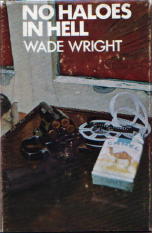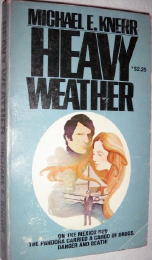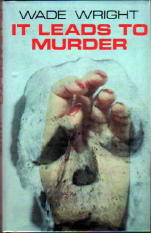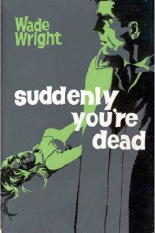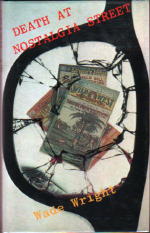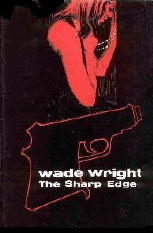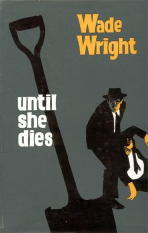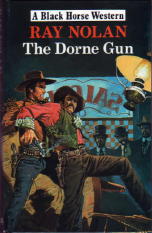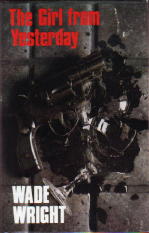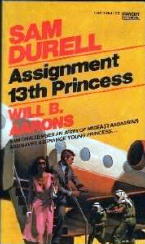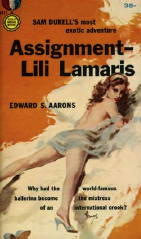February 2007
Monthly Archive
Wed 28 Feb 2007
Following the
interview with John “Wade” Wright here not too long ago, I’ve been asked to say some more about his recurring characters. (Preceding the interview is a list of all 14 of his mystery novels.)
I still don’t have access to copies of his books myself, and while I’ve purchased two or three in the last couple of days and they’re on their way to me, that doesn’t do me any good right now. So I asked Bill Pronzini, who’s read them all, I believe, and here is what he had to say.
Steve:
I don’t have the time to do a full write-up on John’s series characters, but in a nutshell:
Bart Condor is a tough, violent New York private eye inspired by and patterned after Spillane’s Mike Hammer.
Paul Cameron is a more cerebral P.I. built along the lines of Philip Marlowe, Thomas Dewey’s Mac, Bob Martin’s Jim Bennett; his bailiwick is southern California.
Calhoun is a Vietnam vet who works for a shadowy U.S. internal security agency run by “The Man” and whose job is to “help lop off the many tentacles of the racket boys [i.e. Mafia]” by any necessary means, operating close to the law and without any official cover.
The Paul Cameron series is the best of the three. For my taste, though, the best of all John’s novels are the two stand-alones, Death at Nostalgia Street and It Leads to Murder.
Tue 27 Feb 2007
In June 2001 I founded the Golden Age of Detective Fiction mailing list at Yahoo. At that time I had already spent several years reading and contributing to Usenet newsgroups on the Internet, and had become frustrated at their persistently modern focus. My aim was to provide a forum where I could discuss with others the kind of detective stories that I liked; typically those written from the 1920s through to the 1950s, with a focus on investigation rather than – as was the vogue then – cats, dogs, recipes and plucky forensic scientists.
I advertised the new mailing list on several of these groups, as well as the existing groups for fans of such writers as Agatha Christie and Dorothy L Sayers, and was lucky to attract many other people who shared my interest. Like all mailing lists, the membership is rather like an iceberg: for every one member who contributes regularly we have another nine or so who merely lurk underwater, perhaps surfacing once a year with a question or comment about a particular favourite author. The list has grown steadily, and our members now include distinguished mystery authors, critics, editors, publishers and anthologists, as well as just plain fans like me.
Discussions on the list cover a wide range of topics, but from the very beginning there have always been reviews of the books that members have read, and descriptions of authors’ lives and works. Many writers have been profiled in this way, and I hope that their sales figures have shown a corresponding jump! By 2003 it was becoming clear that the mailing list archives were accumulating a good deal of knowledge about books and writers. Unfortunately Yahoo archives are relatively difficult to search and there was no guarantee that the material would be retained. I began looking for another medium which would provide a more permanent and easier-to-search home for the group’s accumulated wisdom.
My first attempt was a blog, which I set up in 2003. I brought the existing reviews across to the blog and added more as they came up in the list. Other members were encouraged to use the blog to post their own reviews directly, but as time went on it became clear that this was not working well. The blog was nearly as hard to search as the mailing list, and the need to register before posting tended to discourage people from joining the blog.
Early in 2005 I started to become aware of Wikis. (In fact we have a family connection to Wikipedia: my brother-in-law is credited with making the oldest surviving Wikipedia edit in 2001.) I began by suggesting that members post their wisdom to Wikipedia, but this didn’t draw much of a reaction, so in December 2005 I took advantage of the free PBWiki hosting service to set up a specialised Wiki about Golden Age works of detection.
It was a strange time for me because shortly before that I had been diagnosed with a serious illness, and had cancelled most of my work commitments in order to deal with it. As it turned out the diagnosis was wrong, so I was left feeling relieved, but rather shattered and with lots of spare time to fill in. The Wiki was an ideal project to occupy my mind for a couple of months. It helped to keep me sane.
I began by putting in the reviews that we already had, and trying to include some information about every author. This involved a lot of web searching, reading back-cover blurbs, and digging through my own small collection of reference books. Each author’s entry includes a Bibliography. Other members have been able to check and add to these details as time goes by.
I am trained in information science – I am an indexer and database consultant and my wife is an indexer and librarian – so it came naturally to me to set up a structured system. The main entry point to the Wiki is via a list of authors’ names. Unlike Wikipedia I chose to invert the names – ‘Christie, Agatha’, not ‘Agatha Christie’. I’m not sure that I could defend the decision but it seemed more natural and comfortable to me to look up Margery Allingham under ‘A’ rather than ‘M’. And first names can vary – is Ms Ferrars ‘Elizabeth’ or ‘E.X.’? Not having Wikipedia’s workforce to set up cross-references and disambiguation pages, it seemed best to keep it as simple as possible.
Choosing an author’s name takes you to a page about that author. Sometimes a lot is known about the author and the page can extend to thousands of words. Mike Grost in particular has contributed a great deal to the author profiles, due to the extensive material he allowed me to bring across from his website. At other times little or nothing is known – for instance, about James R. Langham, an American author and screenwriter – and all we can do is hope that a descendant or fan will come along and add to our knowledge later. For at least one author, A. Fielding, we know less than nothing, since the facts we thought we had – taken from reputable sources – have been cast into doubt by other equally reputable sources. But the advantage of a Wiki is that it is always open to change and improvement. Currently we have about 830 authors listed, but I know that there are many more to come.
The author’s page, as I said, includes a Bibliography. This is supposed to list only their works of detective fiction, but in practice – and especially with obscure authors – it isn’t always easy to pick which is which. When in doubt I’ve tended to include rather than exclude. This list in turn links to entries for each book.
At the moment we have about 7000 books listed and only about 500 reviews, so most of our slots are empty. Some authors are well-covered; John Dickson Carr, for instance, has reviews for most of his books. Others are entirely blank, waiting for some enthusiast to come and fill them in. We add about three or four reviews a week, so we have many years’ work ahead of us.
I’ve included pictures for many of the authors where these are available, and for some books. We only have a limited space, though, so I’ve been sparing with these.
In addition to ‘regular’ detective authors there is a section for ‘one-offs’; people who are known or believed to have written only one work of detective fiction. There are quite a few of these, featuring some distinguished names: CP Snow and AA Milne among others. We also have some of the classic commentaries on detective fiction, including the Haycraft-Queen Hundred and Ronald Knox’s Ten Commandments.
Any Wiki like this, covering a single subject, is going to require making decisions. My working definition of a Golden Age author is someone who produced a book of detective fiction between 1920 and 1960. This means that Conan Doyle just squeaks in with The Casebook of Sherlock Holmes at one end and HRF Keating with Death and the Visiting Fireman at the other. But I have included writers like Edgar Allan Poe who are part of the history of detective fiction.
And what constitutes ‘detective fiction’? I have my own views but in general I have gone along with the experts on this; if someone’s name appears in a book or website about detective stories then I tend to assume they are eligible. A borderline case for me would be Peter Cheyney, currently not in the list, who wrote a great deal about criminals and police, but never – as far as I know – constructed a puzzle plot. Leslie Charteris, on the other hand, is in on the strength of a couple of detection-based novellas. But if someone wanted to add a Cheyney page I wouldn’t object.
A third problem: what to do when two books have the same name? We have a couple of examples of this already, and I’ve simply taken the coward’s way out and listed them both on the same page.
Up to now I’ve done at least 50% of the work on the Wiki. As it becomes more widely known I would like to see others – GAD mailing list members and members of the public – begin to take more of the initiative. Some have made Herculean efforts already; some are still hanging back. A lot of the books mentioned on the Wiki are very rare, and may be in the hands of only a few people; we’d like to bring these to light and revive interest in some of the books and authors that have been unfairly neglected. On the other hand, if someone wants to write a review saying ‘Don’t read this, it’s rubbish’, that’s fine too. It’s all useful information.
One problem with setting up a collaborative system like this is, how much to let go? I want the Wiki to be as easy to use as possible, and this to me means working within a consistent and fairly rigid structure. But GAD fans don’t all have the technical skills to use the codes and other options available within the Wiki. I’ve posted ‘Rules’ that I hope are helpful, but I don’t want to discourage anyone from sharing their knowledge. I suspect that there will always be a certain amount of tidying up to do after the other contributors if the Wiki is to retain its current structure.
The host, PBWiki, has been very supportive. One early problem was solved with a quick email back and forth, and from then on it’s been smooth sailing. We were one of their first customers, and so they’ve grown and developed alongside us, adding features as we were adding pages. It’s quick and easy to obtain a complete backup, which is important, and their search system allows users to locate pages relatively quickly. They’ve recently added a new editing system which should also make it easier for people to contribute.
I don’t see the Wiki as standing in isolation. On the contrary, it wouldn’t have been possible without contributions and material from all over the Internet. Ten years ago it looked as though classic detective fiction was doomed to wither away as authors died and the books became increasingly hard to get. But thanks largely to the Internet, the people who do value these writings can get together and share their knowledge and skills. I’ve learned a great deal in the process and I hope that others have too.
Many of the earlier books are now available online, and despite the current growth in restrictive copyright laws I hope that ultimately they all will be. When that happens people all over the world will need a place to go where they can find out more about these wonderful works, and the Golden Age Wiki will be there for them.
To join the Golden Age of Detection Mailing list go to: http://groups.yahoo.com/group/GAdetection/
To view the Golden Age of Detection Wiki go to: http://gadetection.pbwiki.com.
Contributors can log in with their email address and password: ‘goldenage’. Please read the Rules first!
—
>> This is Steve. Jon submitted this at my request, and what he says goes the same for me.
Tue 27 Feb 2007
You won’t find Jerome Whelan’s name in Allen J. Hubin’s Crime Fiction IV, at least not under that name. You will find him, however, in the online Addenda that preceded the Revised CFIV, which has not yet published. The entry appeared then as follows:
BRIEN, R. N. Pseudonym of Jerome Bernard Whelan.
The Missing Solicitor. Skeffington, 1952 [Eng.]
Four or five copies of the book are currently being offered for sale on the Internet, so it is not especially uncommon. Nonetheless, not only was Mr. Whelan an author new to CFIV, but so was the title itself, even under the pen name, having escaped notice for one reason or another through four editions of the Hubin bibliography.
At the moment I cannot tell you exactly what the mystery in The Missing Solicitor is about, but I have a pretty good guess. In a recent email to Al Hubin, Edward Whelan, a barrister in England, said “Jerome (my father) was a solicitor himself, and obviously did not want any of his clients to know that he had a secret fantasy world of arsenic poisoning and stolen bearer bonds.”
According to Edward, as he mentions in the same email, the name R. N. Brien came from a variation on his mother’s maiden name. There was also only the one novel, which his father always spoke about in a deprecating fashion.
Jerome Whelan went on to become a noted tax advisor and a director of the Ionian Bank in London. He was born in Cork in 1911 and died on 14 Feb 2007.
Tue 27 Feb 2007
Uploaded this morning was Part 11 of Allen J. Hubin’s Addenda to the Revised Crime Fiction IV. Most of the data in this installment consists of identifying authors who have entries in the online Contemporary Authors, previously not so noted.
As usual, however, included also are all the additions and corrections uncovered since Part 10 was completed, of which there are many, not the least of which is the inclusion of two hitherto unknown titles by author Michael Knerr. (See the review of Travis here on M*F immediately preceding.)
Mon 26 Feb 2007
M. E. KNERR – Travis
Pike Book #214; paperback original. First printing, April 1962.
I seem to be specializing in obscure books this month, and this one is about as obscure as you can get. Even though it is a private eye novel – and I’ll get back to that in a minute – it was published by one of those small sleazy paperback outfits in the early 1960s that promised more than they could possibly deliver at the time. And even so, if you happened to have purchased this one in 1962 for its sexy parts, you’d be sadly disappointed, since in that regard, it’s really rather tame. If sexy passages were what you were looking for back then, you’d have been far better off buying a copy of Peyton Place than this.
This book does not even appear in Al Hubin’s Crime Fiction IV, but it will, or at least in the Addenda. The author does appear, however, and to show you something of his track record, here’s his present entry:
KNERR, MICHAEL E. (1908?-1984?)
* Operation: Lust (Epic, 1962, hc) as by M. E. Knerr.
* The Violent Lady (Monarch, 1963, pb)
Listed below are other titles by Knerr (under either byline) which I found listed for sale at various places on the Internet, but not included in CFIV, and probably for good reason. I do not have descriptions of the story lines for any of these first three, so your guess is as good as mine:
* Brazen Broad (Pike #206, pbo, 1961)
* Heavy Weather (Belmont/Tower, pbo, 1979) [** -See
UPDATE below.]
* Port of Passion (Imperial #737, pbo, n.d.)
These I found descriptions for:
*
Night in Guyana (Belmont/Tower, pbo, 1978) A non-fiction account of the of the mass suicide of the Jim Jones cult.
*
Sasquatch: Monster of the Northwest Woods (Belmont/Tower, pbo, 1977) Quoting from the cover: “Though based upon factual research, this is a fictional tale of what could conceivably happen in the Pacific Northwest: a chain of events that could create a monster out of a normally timid and gentle giant.”
*
The Sex Life of the Gods (Uptown Books #703, pbo, 1962) “Science Fiction erotica.”
[** UPDATE 02-27-07] At first I was doubtful, but now that I’ve found a cover scan of Heavy Weather, I’d say that it’s also a prime candidate for inclusion in Crime Fiction IV. If you can’t make out the small print on the bottom of the cover, it says, and I quote: “On the Mexico run the Pandora carried a cargo of drugs, danger and death!” LATER THE SAME DAY: Al Hubin agrees. In it goes. (The book pictured below is described as a Horwitz edition published in Hong Kong.)
But let’s get on with things and to the book Travis itself. There’s only one copy offered for sale on the Internet, making it not only obscure but scarce. I mention this even though I’m sure you know that the two are usually, but not always, one and the same.
Telling the story, though, in his debut and probably his only appearance in print, is Mike Travis, a “sailor of fortune, who loves life, and woman, especially women.” It is not difficult to deduce what other reasonably well-known character was the inspiration for Mike Travis. Travis in this book had previously been in the charter boat business in Florida, but when times went bad, he went to California to accept an offer made by one of his former customers, a multi-millionaire named Del Houston, to look him up if and when Travis headed out that way.
And Del does indeed have a job for him. After some quick string-pulling and the greasing of certain political hands, Del hands Travis a PI license and a gun, and a three-fold request: to find his son; get him off narcotics; and break up the gang who’s been supplying them.
It’s not a bad opening for a PI yarn, and the story maintains its way reasonably well for about half of its just under 160 pages: the usual PI stuff, the things that PI’s do, and the usual bad things happen to some of the people who just happen to get in the way, with all of the coincidences that make one or more aspects of one PI investigation dovetail nicely into another.
Even though it goes without saying, I’ll say it anyway. Travis himself is one of those guys who is irresistible to beautiful women. In this book that includes both his employer’s foster daughter, from page 20 …
She had a body to make dead men come to life and dead women come back to haunt their living husbands. With a skin tone tanned to an almost artistic hue, hair the color of a burnished copper skillet, eyes as blue as an ocean trough and lips as soft and warm looking as an afternoon at the beach, Abby Houston was a woman to set pulses racing and libidos leaping. Mine was right up there too.
… and a stripper who the first time they met, tripped him into a pool at Houston’s house. From page 68:
Marcia, if that was her real name, was rigged up in the getup of an Indian squaw, but the way she filled out the tan buckskin and beads of her ensemble would have made Pocohontas whirl in her grave. If this was an example of the way that Indian women of a hundred years ago, I could see why the west had been wild.
I think you can tell a lot of about a story by looking closely at how the author describes his characters, don’t you? With an ending that doesn’t directly address the clues that have been set up for it, though, the tale does two things simultaneously and hence the apparent impossible. The action-packed finale (a) goes all but out of control, and (b) withers away from lack of interest, as if there were a deadline set that had to be met, and it didn’t matter precisely how.
Although overall not without flashes of acceptable writing, and every once in a while better than acceptable, the overall impact of this novel is still rather like a third-rate Carter Brown or a tenth-rate John D. MacDonald, either of whom, if you’re a fan, you know what I’m talking about and whom you’re far better off pursuing.
Or let’s put it this way. One of the reasons for collecting and reading unknown and long-neglected works of mystery fiction is the hope that never dies of discovering an unknown and long-neglected classic of mystery fiction. Sometimes you have to settle for unknown and long-neglected.
— written in December 2006
UPDATE [02-26-07] If you were to google “M. E. Knerr” on the Internet, you would find, as I did, that there was a Michael E. Knerr who was a friend of SF and (occasional) mystery writer H. Beam Piper, who committed suicide in 1964 when he ran into financial troubles. I’ve not been able to confirm that the two Knerr’s are one and same, nor have the birth and death years for either one been verified. Accounts vary on the latter. Knerr may have also written under the name of “Brent Hart,” but that’s another loose end not yet tied down.
But the Knerr who was a friend of Piper apparently wrote a hitherto unpublished biography of him, and upon Piper’s death, went through his manuscripts and salvaged, among other things, the “lost” third Fuzzy novel, Fuzzies and Other People.
If and when I know more, I will as always, let you know.
[UPDATE #3] Postdated 03-29-07 on 08-16-07. Thanks to Google, I discovered that SF writer John F. Carr knew Mike Knerr, and after a small amount of effort, I was able to get in touch with him by email. As a consequence of this contact, John has posted a long article about his friendship with him here on the M*F blog. I should pointed this out more clearly before now, instead of leaving it hidden as one of the comments.
In this article about Mike Knerr, Carr has his correct date of birth, along with the year he died, plus a lot more about him on both a professional and a personal level.
Sun 25 Feb 2007
Posted by Steve under
Authors ,
Reviews1 Comment
That there’s not enough time in the world to read everything you want to is something I am sure that every non-casual reader of this blog knows full well, even if you restrict yourself to mystery, crime and detective fiction –- or even only a small nook and cranny of the genre, which maybe you do but I try not do. I like to keep my horizons are wide open as possible, although there are some topics and/or themes at which I draw the line (and about which I will tell you some other time).
And when you discover a blog dedicated to one of those small nooks and crannies of the genre, chock full of books you never knew about before, much less you’ve ever read any of them, why, it’s enough to make a grown man (or woman) cry. Figuratively speaking, of course.
This is what happened to me this evening. The particular nook is International Noir Fiction, and the link will take you there immediately, if you’re so inclined.
I’m not sure if Glenn Harper does all of the reviews and commentary, but at a first go-through on my part, it appears that he does. He does one or two posts a week, and going down through the current page, here are the recent objects of his attention:
LEIF DAVIDSEN – Lime’s Photograph [Danish emigre living in Spain]
JAMES CHURCH – A Corpse in the Koryo [North Korea]
MANUEL VÁZQUEZ MONTALBÁN – The Buenos Aires Quintet [Spanish detective in Argentina]
GENE KERRIGAN – Little Criminals [Ireland]
ÅSA LARSSON – The Blood Split [Sweden]
QIU XIAOLONG – A Case of Two Cities [China: Inspector Chen]
PACO IGNACIO TAIBO – The Uncomfortable Dead [Barcelona detective Pepe Carvalho]
PERNILLE RYGG – The Butterfly Effect [Scandinavian sort-of private detective Igi Heitmann]
All worthy, I’m convinced, of hunting down and reading, if only my bank account didn’t have this huge and near-permanent dent in it. I won’t comment on the books themselves, as Glenn’s read them and I haven’t, and he’s already done a super job of it. This list essentially covers the month of February, and the month’s not yet over. Oh, as the man said, my.
A big thanks to the post on The Rap Sheet that J. Kingston Pierce just did along these same lines and which pointed me in Glenn’s direction. At least I think I should thank him. Maybe he’s not forgiven me for confusing his name with that of western fiction writer Frank Richardson Pierce in a recent blog entry of mine, since corrected, and he’s getting even. (He also points out Wade Wright, the subject of the preceding entry here on M*F, as an author whose books he’s newly found as worthy of the chase. You and me both, Jeff.)
Fri 23 Feb 2007
As a short introduction and to put events into the order in which they occurred, not too long ago John Wright saw Bill Pronzini’s
profile of mystery writer Robert Martin on the original
Mystery*File website and got in touch with me. He and Bill had been correspondents and friends for many years, due in part to their mutual admiration of Martin, author of the PI Jim Bennett stories, before eventually losing track of each other. I was able to reunite them by email, not realizing that John Wright from South Africa was also really Wade Wright, a mystery writer in his own regard.
After learning more about John’s career and his interests and background in a good many fields, I asked if he’d care to answer a few questions about himself, and he graciously agreed. I formulated the questions, Bill added two or three of his own, and we sent them off to John. The result of all this is what follows. –Steve
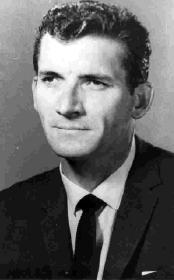
John Wright about the time that
Shadows Don’t Bleed was written.
Q. Thanks for taking the time to talk to us about your career. Unfortunately (and correct me if I’m wrong) none of the mysteries have been published in the US. I’ll begin therefore with a list of all of the titles Al Hubin has for you in his bibliography of the field, Crime Fiction IV:
WRIGHT, WADE; pseudonym of John Wright, (1933- )
* Suddenly You’re Dead (n.) Hale 1964 [Bart Condor; New York City, NY]
* Blood in the Ashes (n.) Hale 1964 [Bart Condor]
* A Hearse Waiting (n.) Hale 1965 [Bart Condor; New York City, NY]
* Until She Dies (n.) Hale 1965 [Bart Condor; California]
* Blonde Target (n.) Hale 1966 [Bart Condor; New York City, NY]
* Shadows Don’t Bleed (n.) Hale 1967 [Paul Cameron; California]
* The Sharp Edge (n.) Hale 1968 [Paul Cameron]
* No Haloes in Hell (n.) Hale 1969 [Paul Cameron]
* Two Faces of Death (n.) Hale 1970 [Bart Condor]
* Don’t Come Back! (n.) Hale 1973 [Calhoun]
* The Hades Hello (n.) Hale 1973 [Paul Cameron; Los Angeles, CA]
* It Leads to Murder (n.) Hale 1981 [California]
* Death at Nostalgia Street (n.) Hale 1982 [New England]
* The Girl from Yesterday (n.) Hale 1982 [Calhoun; U.S. Midwest]

I have a confession to make. While Bill has many of your books and has read them, at the present time I don’t have any of them, or if I do, I don’t have access to them. I’ll defer to you to tell us something about them. I’m going only by the titles, but I’m willing to guess that both Bart Condor and Paul Cameron are private eyes. How close am I?
A. As close as you can get. Condor was the first, and there is no doubt at all I’d been influenced by Mickey Spillane and his Mike Hammer. In fact, it was probably Mickey who really got me started.
I’d written to him, care of New American Library, to say thanks for a lot of very enjoyable reading. Mickey replied by way of a pretty long letter that ended with: “Keep writing and make lots of money.” At the time I was knocking out an occasional article or short story, but that was it.
Q. Tell us more about some of the individual books?
A. I guess the “make lots of money” bit must have stuck somewhere in the thing I call a mind, because a year or so later —
I was holding down a job as General Sales Manager for a nation-wide engineering company, often putting in eleven hours a day. I’d recently married and before doing so had contracted to have a house built in a place called Western Hills, Port Elizabeth. I woke up one morning with the realization that for the first time in my life I owed money, and the feeling wasn’t at all comfortable. Even more uncomfortable was the knowledge that, though pretty good at my job, I did not enjoy working for a boss.
I’ve forgotten what it was all about, but there was a morning when I had a blow-up with my boss. At lunchtime I drove home and spent two hours hammering my Olivetti portable — completing the first two chapters of Suddenly You’re Dead. A couple of weeks later I finished it and sent it to a New York agent who felt it was marketable but needed some fixing — for a price. Declining the offer, I had the MSS sent to London International Press, a recently established firm of literary agents. They agreed to handle the work and sold it to Robert Hale Limited, whose contract included first option on the next three books.
Suddenly You’re Dead paid off the mortgage on the house.
Like most everything else that followed it was written with an eye on the clock. Working in the engineering, construction, and contracting fields has created a habit of measuring everything terms of time, material and reward. Usually a book was written at the rate of a chapter a night, sometimes more, and seldom consecutively. Often I’d be away from home, not able to get back to my desk for days. Perhaps, had conditions been different, had I devoted more time to them, the books may have been a little better than they are. But that’s water under the bridge and I take the rap for everything.
I hated the hypocrisy of the business world, the brown-nosing and backstabbing, and quit some 30 years ago. After doing so the Company asked that I consider the post of a Project Specialist — a fancy name for trouble-shooter. I submitted a proposal, which I expected to be thrown out. It wasn’t, and I signed a six-month contract that had me driving or flying all over the country, and away from home from Monday morning until late Friday night. Since then I’ve been freelancing.
Q. Bill considers Death at Nostalgia Street, whose protagonist is editor of a string of movie nostalgia magazines, to be your best novel. Do you agree with him?
A. I believe Bill would be a better judge than me, so I’d have no trouble accepting his opinion. Certainly I enjoyed writing that one, possibly because I’d always been interested in the publications Nostalgia Street Enterprises handled. Then, too, I’d developed a liking for stories played out in places other than big cities.
Q. When did you first start writing? And why did you sign yourself Wade Wright rather than John Wright?
A. I imagine it started in grade school. I disliked the prescribed reading the school offered, preferring comic books, pulps, Leslie Charteris, Earl Derr Biggers, and a couple of others. Frequently I’d catch hell for bringing comics or pulps to school, to trade with a couple other kids.
What I liked least of all were the essays we were required to write . . . stuff like “My Holiday On The Farm.” Most kids I knew had never seen a farm. But when an open subject was available I didn’t mind a bit. Afterwards, in spite of receiving good marks, I’d be lectured about writing of gangsters, fascist agents or spies, warned that with those sort of notions I’d very likely wind up as a delinquent, or worse.
As for the Wade Wright tag … it was chosen essentially to keep my private and business lives completely separated.
Q. You live in South Africa. Have you always lived there?
A. Most of my life. I spent two years bumming around what was then the Rhodesias — now Zambia and Zimbabwe — keeping one step ahead of the immigration authorities, working at anything to make a buck. In those days that part of Africa was often referred to as God’s Country. Everything was plentiful, and cheap. Jaguars were nearly as common as Fords! I instructed at a judo school, performed as a nightclub photographer, raced stock cars, and somehow became involved with contributing to the sports pages of a newspaper. On occasion I sold short-shorts to another weekly.
On my twenty-first birthday I woke up with a pretty bad hangover, the equivalent of $2.40 in my pocket, and not a friend in sight. Lots had to be learned the hard way.
Q. Why did you choose to set all of your mysteries in the US? Have you ever visited here?
A. Though I lived in a country that was still a colony of The British Empire, and was born from Irish and Welsh stock, I’ve always identified more with the US than Britain. Possibly early reading habits and a love of movies helped a lot. Yes, I’ve been to the States, but it was a long while ago. Always intended returning, possibly for good, but moral obligations determined otherwise.
Q. What mystery writers had the most influence on you in your writing career? Do you have any favorite authors today? Are there “forgotten” writers whom you’d most like to see back in print?
A. They all had some influence, I’m sure. I was probably 14 or 15 when I found cheap hardback editions of Chandler’s The Big Sleep and Farewell My Lovely, and they steered me onto yet another path. As mentioned earlier, it was Mickey Spillane who really got me writing. But the writer I really hold in high regard is Howard “John Evans” Browne.
Of today’s writers Bill Pronzini has to be my favorite.
There are many I’d like to see back in print, especially Robert Martin, and three other authors whose books or stories have always found special places on my shelves — William Campbell Gault, Thomas B. Dewey, and Jack Finney.
Q. As I understand it, you grew up listening to the radio. What we call “old-time radio” here in the US did not last as long as it did in South Africa. Tell us about some of your favorite shows, and in particular, for those not familiar with the story, what was your part in saving the South African version of The Avengers for posterity?
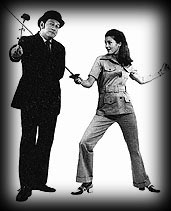
Donald Monat as John Steed and
Diane Appleby as Emma Peel —
South Africa’s
Avengers.
A. Early days of South African radio were fashioned after the style set by the BBC -– British Broadcasting Corporation — so for a long while, for me, a radio was but another piece of furniture. Then, one night I heard these mysterious voices and perhaps a scream, and for the first time gave the radio real attention. I’ve no idea what the show was, but a jaded memory suggests it might well have been an adaptation of Edgar Wallace’s Grey Face. But it wasn’t until the introduction of commercial radio, by way of Springbok Radio, that I really began to enjoy the medium.
The reason is easy to explain. Years earlier I’d found three back issues of the American magazine Radio Mirror on sale at Woolworth’s for 5 cents each. (Still have them.) Those magazines contained articles about the Grand Ole Opry, Perry Mason, Dr. Christian … the logs listed The Shadow, The Fat Man, Box 13 … That, I figured, was radio.
Springbok Radio offered many of those shows, Bold Venture, Richard Diamond — and the likes of Nightbeat, The Hidden Truth, and Superman, canned in Australia. And, of course, the soaps.
I’d started recording these shows and trading them with American OTR collectors. Along the way I came in contact with a legally blind fellow in New York who was anxious to secure copies of The Avengers, a locally produced radio series based on the British TV series. I had no idea then that a number the shows I recorded would turn out to be the only copies saved on tape. Since then a great many South African shows I recorded and traded have turned up in the lists of OTR dealers.
Q. You were also involved with early comic book fandom. How did that come about?
A. The day my older sister brought home a copy of Superman #4. I was immediately hooked; afterwards devouring any (American) comic book I could get my hands on. A consequence of this was that I could read a little before starting school, and that forever after, most required reading matter would seem tame and boring.
I never knew his name then, but Joe Simon’s work on Blue Bolt, really grabbed me. A long time later I’d discover his Captain America, Stuntman, Boys Ranch, and other features. Instinctively, I always believed that he, Joe Simon, was the creator of Captain America, but it was not until the release of his book, The Comic Book Makers, that I found this to be fact.
And it was Joe Simon who introduced me to Comics Fandom. I’d stumbled across his name in Writer’s Market, listed as editor of Sick, and wrote to him, asking if he were the Joe Simon who’d produced so much truly great stuff for the comics. Indeed he was, and not only did he provide an immediate reply, he also sent sample copies of Sick. It so happened that my letter had arrived within a short time of him receiving the first issue of Alter Ego, the first of the comics’ fanzines.
Mr. Simon thought I’d be interested and provided the address of the publisher, Dr. Jerry G. Bails, who passed away in November 2006, at the age of 73. Jerry also wasted no time in contacting me and shooting across the debut issues of his fanzine. The manner of production — printed on a Ditto Duplicator — intrigued me. We had such a machine in the office, but as far as I was concerned it was strictly for printing inter-office notices or price lists. I got hold of a master and a few sheets of duplicating carbon, knocked out a cover and for lack of a better name titled it The Komix.
The cover came out pretty well. But now, with 200+ copies printed there seemed to be a need for a story to fit it. Eventually I had about 40 pages to staple together into a fanzine. What I didn’t know was that it would the first comics fanzine to be published outside of the US. Nor that on eBay copies of the second issue would one day sell for as much as $70.00 each.
I published only two issues of The Komix, had planned a third, but pressure of work was really cutting into my time. Often I’d be in four major cities in the same week. And then Suddenly You’re Dead was sold and I was committed to produce more.
Q. Tell us about your series of Western novels published as by Ray Nolan?
A. These were started when my publisher opted to quit mysteries. Like most boys I loved the B-Westerns. Also the pulps such as Fifteen Story Western, Dime Western, Texas Rangers, etc. So the transition wasn’t difficult and I enjoyed doing them. What I didn’t enjoy was an editor trying to maintain political correctness, oft times even endeavoring to eliminate references, which might be considered even remotely offensive.
The pseudonym, by the way is derived from two men I have always greatly admired. My friend, singer songwriter and actor, the late Ray Whitley, and the legendary Bob Nolan, who penned such Western classics as “Tumbling Tumbleweeds”, “Cool Water”, and so many others.
Q. You’ve done quite a few radio scripts for South African radio and short fiction for S.A. publications. Name some of the programs you’ve written for and the magazines in which you’ve been published. Did you find short stories and radio scripts easier to write than novels?
A. Writing for radio was fun — and lucrative. I’d tried years back to break into the medium but it was something of a closed club. Finally I gave up. About 30 years ago, at a time when all shows on commercial radio were from local production houses, I happened to listen to a particular show and while doing so came up with a story idea. Next day I hacked it out and sent it to Springbok Radio’s head office. There, a fellow named Ben Swart, was good enough to write and tell me that the series was contracted and did not accept outside contributions. He had, however, taken the liberty to send my script to André Bothma, a producer operating in Cape Town. André bought it and asked for more, and soon a very enjoyable relationship was established, though I never ever met him or attended any recording session.
The real break came when André phoned to say he’d like me to write for The Deciding Factor, a 45-minute show that aired on Sunday nights and attracted more listeners than any other. Could I start off with three scripts? He suggested themes for two and left the third for me to choose.
“When will you need them?” I asked.
“Oh, by next Friday will be fine.”
And that’s how it went. I wrote about 200 scripts for The Deciding Factor, Suspense, Radio Theatre, Tuesday Theatre, and others. Contracts were more than extremely fair. Fees continually rose, and they covered two broadcasts within a period of 14 days. If a show was again aired after that period the writer was paid 50% of his current fee.
André was an innovator and one of the best in the business. Never afraid to stick his neck out he’d try anything, and we had fun using werewolves and banshees, and even stories like Charley’s Amazing TV Set. Good times. Fun times.
The first two stories I ever wrote and sold were to a new magazine titled Yours. It boasted the worst covers I have ever seen on any magazine. I was 15 at the time, but already working. Unfortunately neither were published because Yours went belly-up. Ten years afterward, or perhaps even later, I found one of the stories, changed the name from “Ain’t Nobody Honest?” to “Stopover At Nathan,” and a British agent sold it to London Mystery Magazine. It was subsequently reprinted, but I no longer have any record of it.
When we sold our home at Bluewater Bay, a number of cartons got “lost” in moving, among them recorded tapes of the radio shows for which I’d written, manuscripts, and lots of personal and valued correspondence.
Other stories have appeared in such local slicks as Family Radio & TV, Fair Lady, You … feature articles in Weekend Post, Leisure, etc – usually under other pseudonyms. Articles on show business personalities have been published in the US, in Under Western Skies, Nemesis, Screen Thrills, Classic Images, and possibly others.
I’ve found scripting for radio the easiest. Usually I could get a story finished in a day. It was also less hit-and-miss than writing for magazines. The entire manner of conducting business was also completely professional. Acceptances were fast, and your check arrived within 30 days. The downside of it was that often the broadcast sounded nothing like the sounds heard in one’s head when pounding the typewriter.
Q. Overall, what’s given you the most pleasure in your writing career?
A. The work and the people with whom it has brought me in contact. Most gratifying has been to find that those of real substance are invariably the most down to earth.
—
SHORT STORY BONUS. I’ll let John set the stage:
A tale’s attached to this short.
A colleague asked me about plotting, and while explaining what I did, worked out a complete plot for him – based upon his habit of visiting the pub in question. He never used it, which was no surprise.
On a Sunday morning some months later, I remembered the thing, made a few changes, and put it on paper … with no idea what I’d do with it. The very next week I received a letter from a friend — possibly Bill — telling me about the new Black Mask, suggesting I might think of sending them something.
I sent “Waiting,” and they bought it right away. But then they shut down but paid a kill fee, returning all rights. Later still it was accepted by Black Lizard, but I heard no more from that end. Maybe I should have followed up.
Anyway, though it has earned some good money, the story has never yet seen print. If you find it the least bit interesting, you’re free to link it to your site.
UPDATE [02-24-07] Four additional cover scans have been added since the interview was first posted.
Fri 23 Feb 2007
In case you haven’t read or heard about it already, Stephen Marlowe, author of the Chester Drum series, recently appeared on Ed Gorman’s blog, telling the story of how he and Richard Prather, author of the Shell Scott PI novels, got together and wrote Double in Trouble, their magnum opus in which their two characters met and cracked a case together, after first cracking their heads together, thinking that each of them was on the other side.

The story is fascinating, and by all means, you should go read it. What I don’t know is whether you should read Marlowe’s long reminiscing story first, or to give it some additional background, you might want to read J. Kingston Pierce’s post on The Rap Sheet site before you stop over at Ed’s. Jeff has a great knack of finding a news item elsewhere on the blog and writing about it on his own, adding as he does so a profusion of links and insights to the original post, wherever it may have been. It’s one of the few sites where I stop by everyday, and Ed Gorman’s is another. With his long career in mystery fiction and other genres, Ed knows the authors and the publishers, and he has many well-formed opinions and perspectives of the field, all of which spills over into his daily posts.
Returning to Marlowe and Prather’s work together, I’m not sure if this the first example where two authors joined forces (and characters) in a novel, sharing a joint byline together. In 1963, Stuart Palmer and Craig Rice published People Vs. Withers and Malone, a collection of short stories in which their detectives, Hildegarde Withers and John J. Malone either shared or battled wits together. Most of the stories were written before 1959, which is when Double in Trouble first came out, but whether or not that counts, I don’t know.
I’ve asked this question before, I know I have. What I don’t know is if I received an answer or not. Those who forget history are doomed to repeat it, as some wise philosopher once said.
Here’s another question. Richard Prather’s passing has been widely reported on various blogs and newsgroups, but as far as I know, it has yet to have been noted by the mass media. Why not? If you were to Google “richard prather obituary” as I did just now, the piece I posted on the M*F blog a full week ago today is the first one to come up. Why is that? It looks nice on my resume, I suppose, but come on. I’d agree that at the time of his death Mr. Prather was not a major player in the world of mystery fiction, but he was still certainly a major figure, having sold millions and millions of his (mostly) wacky private eye adventures, second certainly in the 1950s only to Mickey Spillane. Why has the rest of the world ignored his passing?
One more question, and one that’s less of a rant. Prather is gone, but Stephen Marlowe, at the age of 79, is thankfully still with us. Of the major (or even the minor) Gold Medal writers of the 1950s, who else are still alive? Vin Packer (Marijane Meaker) for one, I believe, and she will be 80 this year. Others?
Thu 22 Feb 2007
I’ve been working slowly in annotating the Addenda to the Revised Crime Fiction IV, compiled by author Allen J. Hubin and which I have been posting online.
Here are some fairly recent entries, as I have expanded upon them, often with the assistance of others. Perhaps you will find them as interesting as I did. Even better, if you can add anything useful or noteworthy to these entries, please send it along. You will find your input very much appreciated. Of course, if you find anything that requires a correction, you should let me know that too. I can guarantee you that it will be equally appreciated!
GATES, H. L. American author of eleven crime or thriller novels published between 1921 and 1934, two of them indicated as having only marginal criminous content in the (Revised) Crime Fiction IV.
The Mystery of the Hope Diamond. (Novelization of silent film: Kosmik, 1921, as The Hope Diamond Mystery; also released as The Romance of the Hope Diamond; scw: John B. Clymer, Charles W. Goddard, May Yohe; dir: Stuart Paton.) (Note: May Yohe, 1869-1938, actress and one-time wife of an owner of the diamond, also had some role in the writing of the novel.)
GRAVE, STEPHEN Pseudonym of David J. Schow, (1955- ). A horror fiction writer under his own name; as Stephen Grave the author of six paperback novelizations based the television series Miami Vice, including the one cited immediately below. As Brad Latham, Schow was also the author of five private eye novels set in New York City in the 1930s with Bill “The Hook” Lockwood as the leading character.
The Florida Burn. TV movie [series episode/Miami Vice]: Michael Mann, 1984, as Brother’s Keeper (scw: Anthony Yerkovich; dir: Thomas Carter, Neil Gordon). Add SC: Det. James “Sonny” Crockett (Don Johnson) & Det. Ricardo “Rico” Tubbs (Philip Michael Thomas)
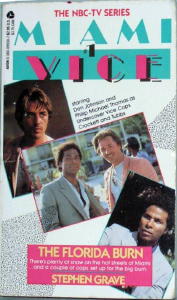
[Note: It is likely but not yet confirmed that Crockett and Tubbs should be added as SC to the other books in the series; see below. These books were based on either 60-minute episodes or combinations of two 60-minute episodes, not considered to be movies. Only the first two books in the series were published in the US.]
China White. [Miami Vice #4]
Hellhole. [Miami Vice #6]
Probing by Fire. [Miami Vice #5]
The Razor’s Edge. [Miami Vice #3]
The Vengeance Game. [Miami Vice #2]
HAMILTON, LYN
The Celtic Riddle. TV movie: CBS, 2003, as Murder She Wrote: The Celtic Riddle (scw: Rosemary Anne Sisson, Bruce Lansbury; dir: Anthony Shaw). SC: Lara McClintoch does not appear in the film; she was apparently replaced in her role by “Jessica Fletcher” (Angela Lansbury). Note: For a review of the movie relative to the book, see (for example) www.blogcritics.org.
HAWKINS, DEAN. 1892-1955. Pseudonym of Benjamin Hawkins Dean, q.v. Born in Mississippi, graduated from the University of Mississippi but lived in Florida most of his life; worked in the paper business. Author of four detective novels in the (Revised) Crime Fiction IV, including the one cited below. Add real name and birth & death dates. [Thanks to John Herrington and Victor Berch for uncovering both.]
Headsman’s Holiday. Add setting: Florida. Leading character: private eye Pharaoh Pharr.
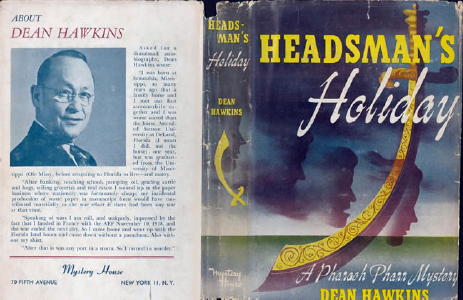
HEATH, CHARLES Pseudonym of Ron Renauld, author of many TV tie-in’s and books in men’s adventure series (Able Team, Airwolf, etc.) under various pen names and house names. Several other “A-Team” novels that he wrote are probably adaptations of 60-minute episodes of the TV program.
The A-Team. TV movie [two parts]: Universal, 1983 (scw: Frank Lupo; dir: Rod Holcomb) . SC: The A-Team: Col. John “Hannibal” Smith (George Peppard), Capt. H. M. “Howling Mad” Murdock (Dwight Schultz), Sgt. Bosco “B. A.” Barracus (Mr. T) & Lt. Templeton “Faceman” Peck (Tim Dunigan). Note: Dunigan played Peck for this series pilot only; Dirk Benedict had the role for the rest of the series.
Tue 20 Feb 2007
Posted by Steve under
AuthorsNo Comments
I received the following as an email from Wynn Manners a couple of days ago, and he’s agreed to let me post it here on the blog. The
article he’s referring to is one done by Doug Bassett on the original
Mystery*File website. At the conclusion of Doug’s essay is a bibliography of all the books in Sam Durell series, followed by the story of how the person behind the Will B. Aarons pseudonym on the last six books was revealed, thanks to Jeff Falco and Al Hubin. You may go read it now, but if you do, don’t forget to find your way back. –Steve
Thanks for your write up on Edward S. Aarons.
Appreciated it — and the listing of all the Assignment series. Looks like I only lack about two of ’em…
Personally I *far* prefer Aarons’s thrillers over John Buchan’s (I *barely* managed to wade thru his 39 Steps & Ian Fleming’s 1930’s-level pulp trash James Bond thrillers (tho I thoroughly enjoy the movies). (Truth-to-tell, I’ve only read *one* by each of these… and started one other volume by each of them. They just didn’t “grab” me. *Yawn.*)
I put Aarons’s books right up there with John D. MacDonald’s Travis McGee series and Donald Hamilton’s Matt Helm series — at the very TOP — better than most of the rest!
Happy to have found out the “inside dope” on Will B. Aarons. I’ve *enjoyed* the “Will B. Aarons” books I’ve read; I thought he did a *good* job by way of trying to fill Edward’s shoes (far, far better than anyone has done writing further Tarzan novels, for example — tho I’d still love the opportunity to read Stu Byrne’s Tarzan On Mars …)
If one gives Edward an “A” — overall (and I *do*!) I’d say that “Will’s” books still deserve a “B.” They’re certainly worth a one-time read.
I started reading the Assignment series back when I was in college (1960-64)… and am *rereading* some of them, all these years later (Lili Lamaris being the current reread). One utterly forgets the story in 20 to 40 years… so it’s “all new” again… Lucked-out at one library sale at the Clarkston (Michigan) Library… someone had collected most of what he’d written, including early 50’s non-Assignment thrillers. (Don’t recall ever seeing the Ace Double Novel ones, tho…)
Aarons keeps ya glued to the book, turning the pages, on-the-edge. *Excellent* storytelling. And I like the wisdom of the way he chose that last name — a double A to put him *first* when books are arranged alphabetically by authors’ last names!
It’s always seemed to me that the connoisseurs “in the know” with a more developed taste go to the likes of Edward S. Aarons and Donald Hamilton — and the plebian masses who just “follow the popularity crowd” — picking up on the latest “best seller” or read the considerably *inferior* Ian Fleming’s James Bond!
Once in awhile I read a “best seller” type of book and understand *why* people were attracted to it (Robert James Waller, for example)… but *most* of the time what is most popular… it’s utterly *beyond* me what people see in it!
I recently acquired a copy of the Edward Gorman edited The Black Lizard Anthology Of Crime Fiction (for two bits, from the back room of our local library) and was delighted to be reading the intro, devoted to Fawcett Gold Medal books… but *appalled* that Edward S. Aarons (& Donald Hamilton, for that matter) were never even *mentioned* (tho I realize that the “thrillers” category is a bit different from the category of hard-boiled detectives he seemed to be focussed upon).
The first two Gold Medal books I remember reading were Richard Matheson’s I Am Legend — bought at O’Dell’s Drug Store as a 10th grader… and the Gardner F. Fox one on Jack the Ripper (the title escapes my mind, at the moment). My Name Is Buchanan by Jonas Ward was read around those years, too…
Cheers!
~~wynn manners
Next Page »
